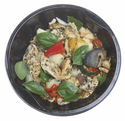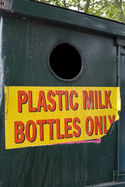Design with green in mind
18 December 2008Steph Carter, Packaging Sustainability Director, Unilever, explains how his company is factoring environmental concerns into packaging design
As most readers will be aware, Unilever is a major multinational, with 400 brands across the sectors of food, ice cream, household and personal care products. We estimate that 150mn families purchase a Unilever product each day. So, we are a major user of packaging of all descriptions, with our activities traversing a wide range of product types, environments and legislative practices, particularly in relation to environmental issues. These vary tremendously around the world, and as products are marketed in numerous geographical areas, they have to comply with many criteria.
Not just packaging
In my opinion, packaging cannot be dealt with in isolation and environmental concerns must be factored into the development process for the entire product. Every aspect is linked and interdependent on several others. This results in an integrated overview of the product from a sustainability perspective. If we only measure separate elements, there may be considerable improvements in one area, but downgrading in other ways, thereby reducing the overall product sustainability. When we are evolving a product, including the packaging, we firstly need to decide which sustainability metrics come into effect. We must determine which aspects of the product need to be measured and how and why they are being analysed.
First and foremost – consider which elements are meaningful to the sustainability credentials of your business. Choose a product that has a big footprint and consider how its sustainability credentials can be optimised. When assessing the product in its entirety, ensure that the sustainability data measurements are easy to measure and remain meaningful. Don’t solely limit your study to that part of the process that you control. It is essential to consider the entire impact of the product – both upstream during manufacture and downstream at the waste processing stage. Only select metrics that are relevant to the product in question – don’t make your measurements against the ‘buzzwords’ being used by you or other companies for different products. Every product type has specific requirements and the true meaning of sustainability will vary accordingly.
Key criteria
However, there are some criteria that are relevant to most product types. Firstly, there are greenhouse gas emissions. These emanate throughout the production and packaging chain, ranging from methane emitted by farm animals through to those resulting from incineration of packaging materials at end-of-life. It is generally recognised that food production results in more greenhouse gas emissions than production and disposal of packaging materials. This serves to reiterate the fact that packaging must embody the required properties to maintain product quality throughout the storage and distribution chain and in the home. Secondly, water use should be minimised and water must be recycled, wherever possible. The water purification process is dependent on a great deal of energy and chemicals usage, all of which impacts the environment.
Manufacturers must try to design their packaging to be suitable for waste disposal streams – particularly allowing materials sorting, recycling and recovery and avoiding the need to landfill. Finally, it is imperative to ensure that the entire product is sourced responsibly, trying to offset carbon emissions to achieve carbon neutrality and ensuring that fair trade policies are adhered to.
More packaging, yet more sustainable
A good example of where smarter, yet heavier, packaging can improve the sustainability credentials of a product can be demonstrated in a comparison between a 100g portion of microwavable French fries and another of oven-cooked French fries. The packaging for the microwaved product comprises 18g of board and 1g of film, whereas the oven-cooked equivalent is wrapped in a 1.2g PE/PE laminate, so on one level the microwave product packaging will have a greater environmental impact. However, the board carton is actually a device that permits microwave cookery to take place, which takes three minutes. On the other hand, the oven-cooked fries need cooking at 200ºC for 30 mins. The power requirements are 1kwh and 0.0424kwh of power for the oven-cooked and microwaved products. Consequently, the respective CO2 emissions are 0.45kg and 0.04kg. The packaging is thus extremely effective in reducing the overall carbon footprint of the product.
Misunderstanding waste
When designing the package, there are elements that should be avoided, wherever possible, to assist with waste management and recycling. For example, it is best to avoid the following in relation to plastic packaging in the developed world:
1. Small plastic bottles – these are difficult to sort from the waste stream using optical systems.
2. Bottles that are manufactured from any other materials than HDPE or PET (specifically those made from PP, polystyrene, PETG, PLA or PVC).
3. Sleeves on bottles made from PVC and other materials – particularly where the sleeve material is incompatible with the bottle material, resulting in confusion for automatic detection systems (i.e. PET sleeves on HDPE bottles).
4. Triple-layer HDPE bottles containing a carbon black inner.
5. Silicone rubber insertions in sports caps.
6. Trigger packs.
7. The use of coloured PET.
8. The adherence of labels with excessive glue.
9. Labels that sink when removed in water.
10. Inks that run off labels when soaked.
Selective assumptions in environmental assessments
When making a materials selection according to sustainability credentials, it is necessary to ensure that selective assumptions have not been made. For example, virgin paper production has a low carbon footprint, as lignin can be used as fuel. However, paper should and is recycled on multiple occasions, which is a very energy-intensive process. When determining the carbon footprint, it is thus more accurate to take a whole-life average.
Local, yet global
If your products are sold in more than one national market, it is necessary to bear in mind the perceptions of waste and the waste management strategies that are effective in each nation and region. A primary distinction is that waste is an issue in the developed world and is collected by local governments as a service. However, in the developing world it is often a valuable resource to be scavenged.
Furthermore, waste management policy varies tremendously between countries, and this should be factored into packaging design. For example, UK strategy is gradually turning against landfill, whereas this disposal system has never been used in The Netherlands. Incineration systems, incorporating energy recovery, are favoured in The Netherlands, Denmark and Singapore, but the USA and UK are striving towards recycling.
The Golden Rule is that it is essential to select the best packaging materials and systems for each application, thereafter minimising the impact of the selected system. Materials should not be selected because they have a low impact or are perceived to be green – they must be chosen for their function and quantifiable environmental impact.
Urban myths
First and foremost, we cannot do without packaging. Food packaging typically embodies less than 10 per cent of the environmental impact of its contents. Its effectiveness in preserving and protecting is far greater than its own impact. Another frequently-heard opinion is that plastics use oil. This is undeniably true but, in fact, they are not made from the oil that is used for vehicle fuel. The problem with plastics is that the relevant waste management systems are only now being brought into effect and the public still needs education regarding recycling policy.
A widely held misconception is that paper is totally sustainable. It is certainly true that paper is inherently renewable, but it actually has a negative whole-life balance as the manufacturing and recycling processes create greater levels of CO2 than are absorbed by trees during photosynthesis. Furthermore, paper generates methane if disposed of in landfill, which has 23 times the greenhouse gas potency of CO2. Also, only 8 per cent of the world’s forests are sustainably managed, so the chances are that most of the world’s paper products are having a direct environmental impact.
Future trajectories
A great many packaging specialists consider that biopolymers represent the panacea to the environmental argument. In fact, these represent an inefficient method of using biomass as there is a great deal of materials wastage. Secondly, there are the well-known issues regarding competition for agricultural land, which can have a detrimental impact on food prices. Biopolymer processing is energy-intensive, resulting in a negative carbon balance, and disposal contaminates the waste stream. In addition, packaging manufactured from biopolymers often exhibits poor technical performance and is not always compostable.
Another myth is that glass is sustainable. It is undeniable that glass has excellent barrier properties, is recyclable and that effective recycling solutions have been implemented in many countries over a long period. However, manufacturing necessitates the expending of large amounts of energy and glass packaging is extremely heavy, rendering it inefficient to transport.
Finally, many consider that the future lies with degradable packaging. The major advantage of these packages is negation of the litter problem. However, they should only be used where the residue of the contents make composting a viable option. The rotting process wastes the embodied energy of the material, and often emits methane. As already stated, this is particularly volatile in environmental terms. Even when it does degrade, the resultant compost is low in nutrients, and thus has a low value as fertiliser. It can also contaminate the waste stream for conventional plastic materials.
The sustainable equation
Defining sustainability is always difficult and it is extremely important to factor all elements into packaging design. Apply the sustainability metrics that are relevant to your business and bear in mind that the least packaging option is not always the best total option. Understand waste management systems and policies on an international level; select the most effective materials for the job and don’t fall into the trap of believing common sustainability myths.
CONTACT
Steph Carter
Packaging Sustainability Director, Unilever
e-mail: Steph.Carter@unilever.com
Steph Carter, Packaging Sustainability Director, Unilever Closed-loop recycling schemes for plastics are gradually being introduced Ploughing the green furrow Even though microwave meal packaging is often heavier than the oven-cooked equivalent, the energy required for preparation is less Calculating the true environmental cost




